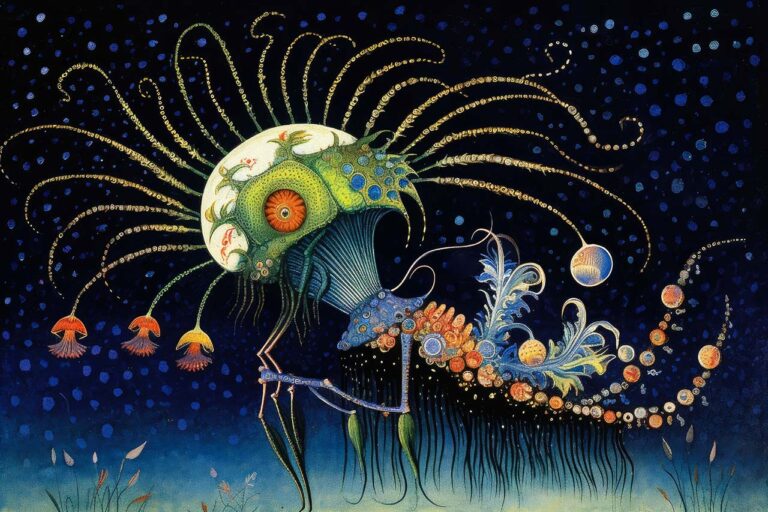
Info
- Digital artwork by Olio Imaginarium
- A series of 52 digital artworks
- Year: 2024
Artwork In brief
”The Horde” evokes the image of an expansive sea of figures united by raw, untamed energy on the verge of chaos. As people blend into the collective psyche of the horde, they become susceptible to acting emotionally and irrationally, driven by primal instincts. When the ’crowd mind’ takes over, individuals may lose their sense of self, setting the stage for both acts of heroism and violent destruction.
’The Horde’ draws inspiration from the Romantic era’s oil paintings, with their grand scale and intricate detail that beckons the viewer’s gaze to wander around the image. In all of the paintings, individuals are engulfed by the ‘crowd mind,’ forming a seemingly single, colossal organism, their bodies densely interwoven. Masses of people flood through the streets like rolling waves or rise toward the sky like raging wildfires. Sometimes this swarm is broken down to a maze of body parts—limbs sticking out and faces distorted beyond recognition—symbolizing an anonymous mass.
The scenes span historical turmoil, such as medieval crusades, World War II-battered cities in chaos, and unified workers’ rebellions, as well as more dreamlike visions with religious undertones. Uniformity is emphasized through repetitive attire amongst the crowd, enhancing conformity. Moreover, in the more dreamlike and dystopian scenes, even the faces of the characters bear a striking resemblance to one another, reinforcing the loss of individuality and the merger into the collective ’crowd mind’.
While the scenes have mostly historical or fantastical origins, one may view them in the light of crowd psychology or even through the lens of today’s social media landscape.
Psychology of the Crowds
Gustave Le Bon was one the first to write about the psychology of the crowds in 1895, and many of his insights remain relevant today. Le Bon proposed that when individuals come together in a crowd, they form a new psychological entity that he called the ”collective mind.” This collective mind is characterized by a lowering of personal responsibility, a decrease in rationality, and heightened emotions and instincts. According to Le Bon, people in a crowd act under the collective identity of the group rather than as individuals.
Le Bon considered anonymity as a critical factor in crowd behavior, as it allows individuals to lose their sense of personal responsibility. This anonymity, combined with the contagious nature of emotions and actions within a crowd, leads to behaviors that individuals might not exhibit on their own.
According to le Bon, crowds are highly suggestible and can be easily influenced by strong leaders or persuasive symbols. Le Bon compared the suggestibility of crowds to the state of hypnosis, where rational judgment is suspended, and individuals are more likely to accept and act on suggestions without critical thinking. While crowds are inherently leaderless and aimless, they can be easily directed by individuals who understand how to manipulate the collective mind. These transformations, according to Le Bon, make the crowd a powerful but potentially dangerous force.
Regrettably, the history of humankind abound with instances of such dynamics. Time and again, we have seen persistent patterns of warfare, ideological conflicts, and collective brutality, as evidenced by the Crusaders, transatlantic slave traders, and the regimes of the Nazis and Soviets. Today, despite significant advancements, the primitive aspects of our psyche persist, scarcely evolved from our cave-dwelling forebears. This is evident in the current social media environment, now plagued by hate speech, anonymous attackers, social echo chambers, and the erosion of critical thought.
Crowd Mind in Social Media
Le Bon’s notion that anonymity in a crowd reduces personal accountability finds a contemporary echo in the behaviors exhibited on social media. Shielded by pseudonyms or a degree of anonymity, users may partake in confrontational behavior that they may otherwise avoid in person. Moreover, the transmission of emotions within a crowd, a phenomenon Le Bon noted, is strikingly relevant to the social media landscape. Research indicates that emotions, whether uplifting or anger, spread effectively through social networks. Viral content often harnesses emotions and employs exagerating effects to engage audiences.
The suggestibility of crowds and their tendency to echo leaders or prevailing ideas, as described by Le Bon, manifest in the formation of online echo chambers and the pervasive occurrence of groupthink on social media platforms. Algorithms curate feedback loops, presenting users with content that resonates with their preexisting views, which in turn fortifies collective identity and minimizes exposure to alternative perspectives.
Furthermore, Le Bon’s focus on the influence of leaders over crowds has its modern-day equivalent in the rise of social media influencers. These personalities wield considerable power in shaping the views, trends, and behaviors of their audience, paralleling the pivotal role that leaders play in directing collective actions within crowds.
’The Horde,’ in light of the theories outlined above, stands as an invitation to perceive the enduring patterns of our nature and, perhaps, in understanding them, find a way to transcend them. It challenges us to envision a future where, by embracing our nature, we might also rise above it, crafting a narrative driven not by the unconscious will of the many, but by the thoughtful actions of the individuals.



